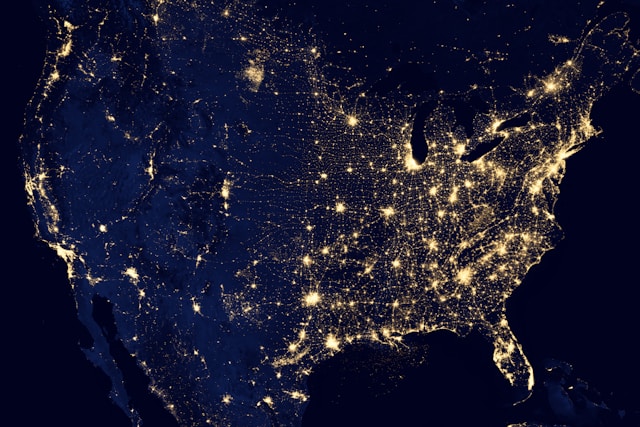Tech
5 Common Trends in the Geospatial Industry
Published
1 week agoon
By
Siraj
The geospatial industry encompasses a broad spectrum of technologies and applications that leverage location-based data to address various challenges and opportunities across sectors such as urban planning, agriculture, transportation, and environmental management. This article will delve into five common trends shaping the geospatial industry, from the adoption of advanced technologies to the emergence of new business models and applications. By understanding these trends, stakeholders can anticipate market dynamics, drive innovation, and harness the full potential of geospatial data for informed decision-making and sustainable development.
1. Integration of Artificial Intelligence and Machine Learning:
The integration of artificial intelligence and machine learning represents a significant trend in the geospatial industry, reflecting a shift towards more advanced and data-driven approaches to spatial analysis and decision-making. As highlighted by trends in the geospatial industry, organizations are leveraging AI and ML algorithms to process vast amounts of geospatial data quickly and accurately, extracting valuable insights and patterns that were previously inaccessible. These technologies enable predictive analytics, anomaly detection, and automated feature extraction, empowering geospatial professionals to make informed decisions with greater efficiency and precision. By harnessing the power of AI and ML, industry players can enhance their capabilities in various areas, including urban planning, environmental monitoring, and infrastructure management. As AI and ML continue to advance, their integration into the geospatial industry promises to revolutionize spatial analysis and unlock new opportunities for innovation and growth.
2. Rise of Location-Based Services and Applications:
With the proliferation of smartphones and connected devices, there has been a surge in location-based services (LBS) and applications that leverage geospatial data to deliver personalized experiences and enhance user engagement. From navigation and mapping apps to augmented reality (AR) games and geotargeted advertising, location-based services are reshaping how people interact with their surroundings and access information. Businesses are increasingly leveraging LBS to offer location-based marketing, real-time fleet tracking, and geofencing solutions to optimize operations and improve customer experiences. The growing demand for location-based services underscores the importance of accurate geospatial data and robust infrastructure to support these applications.
3. Adoption of Remote Sensing Technologies:
Remote sensing technologies, including satellite imagery, aerial photography, and LiDAR (Light Detection and Ranging), are playing a pivotal role in the geospatial industry, enabling comprehensive mapping, monitoring, and analysis of Earth’s surface and atmosphere. Satellites equipped with high-resolution sensors capture imagery of vast areas with unparalleled spatial and temporal coverage, supporting applications such as environmental monitoring, disaster response, and urban planning. LiDAR technology, on the other hand, provides detailed elevation data and 3D models of terrain, vegetation, and infrastructure, facilitating precise mapping and analysis in various domains. The widespread adoption of remote sensing technologies underscores their value in addressing complex geospatial challenges and informing evidence-based decision-making. Aterso01
4. Embrace Open Data and Interoperability Standards:
An increasing emphasis is being placed on open data initiatives and interoperability standards to promote collaboration, transparency, and accessibility of geospatial information across organizations and sectors. Open data platforms, such as OpenStreetMap and NASA’s Earth Observing System Data and Information System (EOSDIS), provide free access to a wealth of geospatial datasets, enabling researchers, developers, and policymakers to harness data for diverse applications. Interoperability standards, such as those developed by the Open Geospatial Consortium (OGC), facilitate seamless data exchange and integration between different geospatial systems and software. By embracing open data and interoperability standards, the geospatial community can foster innovation, accelerate decision-making, and address global challenges more effectively.
5. Focus on Sustainability and Environmental Monitoring:
As concerns about climate change, natural disasters, and environmental degradation intensify, there is a growing emphasis on leveraging geospatial technologies for sustainability and environmental monitoring initiatives. Satellite remote sensing, coupled with advanced analytics and modeling techniques, enables the monitoring of key environmental indicators, such as deforestation, land use change, and air quality, at global, regional, and local scales. Geospatial data plays a crucial role in assessing the impact of human activities on the environment, informing policy decisions, and supporting conservation efforts. By harnessing geospatial data for sustainability and environmental monitoring, stakeholders can better understand ecological trends, mitigate risks, and promote the conservation and management of natural resources.
Conclusion:
In conclusion, the geospatial industry is undergoing rapid evolution driven by advancements in technology, changing market dynamics, and emerging applications across sectors. From the integration of artificial intelligence and machine learning to the rise of location-based services and the adoption of remote sensing technologies, several trends are reshaping how geospatial data is collected, analyzed, and utilized. Embracing open data initiatives, interoperability standards, and sustainability-focused applications can further propel the geospatial industry forward, enabling stakeholders to address complex challenges and seize new opportunities for innovation and collaboration. By staying abreast of these trends and leveraging geospatial data effectively, organizations and policymakers can harness the power of location intelligence to drive positive societal and environmental impact in the years to come.
You may like

Basil Jackson: Constructing Dominant Societies, Rooted in Compassion

5 Ways Medical Cannabis Helps Calm Arthritis

Through Lunch and Learns, Chris Anderson is a Pioneering Leader in the Generation of Leaders

What You Need to Know About Police Brutality?

12 Sites to Watch Free Online TV Shows with Complete Episodes in 2024


